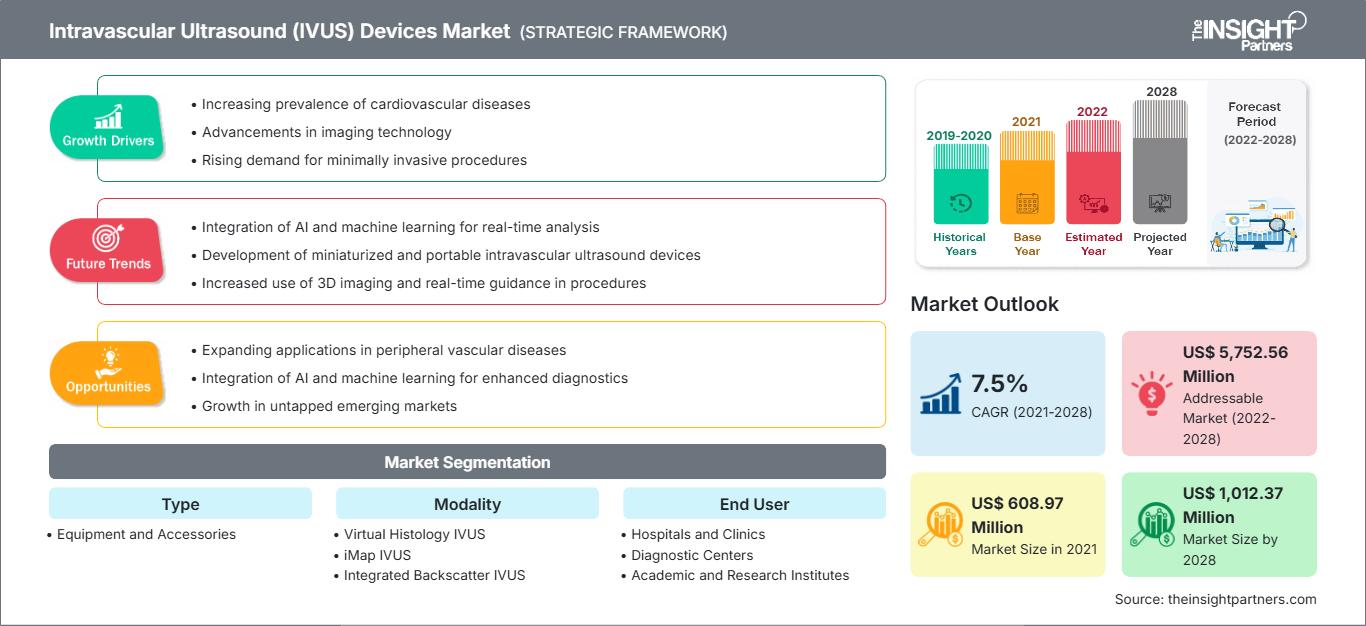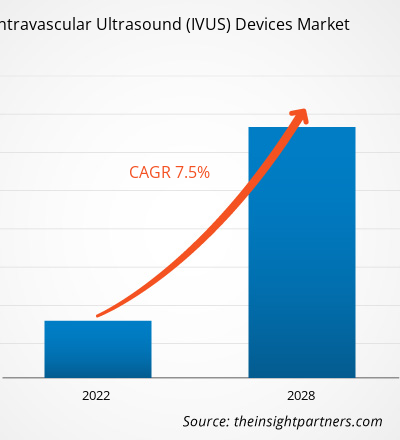[Informe de investigación] Se espera que el mercado de dispositivos de ultrasonido intravascular (IVUS) crezca de US$ 608,97 millones en 2021 a US$ 1.012,37 millones en 2028; se estima que crecerá a una CAGR del 7,5% entre 2021 y 2028.
El informe ofrece información y un análisis exhaustivo del mercado de dispositivos de ultrasonido intravascular (IVUS) en relación con diversos parámetros, como las tendencias y oportunidades del mercado, la dinámica del mercado y el análisis del panorama competitivo de los principales actores del mercado en Norteamérica, Europa, Asia-Pacífico, Sudamérica y Centroamérica, y Oriente Medio y África. También incluye el análisis del impacto de la pandemia de COVID-19 en las regiones.
Personalice este informe según sus necesidades
Obtendrá personalización en cualquier informe, sin cargo, incluidas partes de este informe o análisis a nivel de país, paquete de datos de Excel, así como también grandes ofertas y descuentos para empresas emergentes y universidades.
Mercado de dispositivos de ultrasonido intravascular (IVUS): Perspectivas estratégicas

- Obtenga las principales tendencias clave del mercado de este informe.Esta muestra GRATUITA incluirá análisis de datos, desde tendencias del mercado hasta estimaciones y pronósticos.
Perspectivas del mercado
Aumento de los trastornos cardiovasculares
Las ECV siguen siendo la principal causa de morbilidad y mortalidad a nivel mundial. Una dieta poco saludable es el factor de estilo de vida más importante que las provoca. Según la OMS, las ECV fueron una de las causas de muerte, representando casi 17,9 millones de muertes en todo el mundo en 2019.
Algunos de los principales factores de riesgo de las ECV incluyen los antecedentes familiares, la etnia, la edad y otros factores de riesgo: consumo de tabaco, hipertensión, obesidad, colesterol alto, inactividad física, diabetes, dietas poco saludables y consumo de alcohol. La mayoría de las ECV se pueden prevenir mediante el premonitoreo y el prediagnóstico con dispositivos de ultrasonido intravascular. Por lo tanto, el creciente número de ECV está impulsando la demanda de dispositivos de ultrasonido intravascular.
Debido a la pandemia de COVID-19, la demanda de dispositivos de ultrasonido intravascular (IVUS) ha aumentado. Es probable que el mercado de dispositivos de ultrasonido intravascular (IVUS) en Asia Pacífico se expanda rápidamente en el futuro cercano. Esta expansión se debe principalmente a la disponibilidad de técnicos capacitados y altamente calificados, así como a la creciente adopción de equipos de diagnóstico tecnológicamente avanzados.
Perspectivas basadas en modalidades
Según la modalidad, el mercado de dispositivos de ultrasonido intravascular (IVUS) se segmenta en IVUS de histología virtual, IVUS iMap e IVUS de retrodispersión integrada. En 2021, el segmento de IVUS de histología virtual tuvo una mayor participación de mercado. Sin embargo, se estima que el segmento de IVUS iMap registrará una tasa de crecimiento anual compuesta (TCAC) mayor, del 8,0 % durante el período de pronóstico.
Dispositivos de ultrasonido intravascular
Perspectivas regionales del mercado de dispositivos de ultrasonido intravascular (IVUS)
Los analistas de The Insight Partners han explicado detalladamente las tendencias regionales y los factores que influyen en el mercado de dispositivos de ultrasonido intravascular (IVUS) durante el período de pronóstico. Esta sección también analiza los segmentos y la geografía del mercado de dispositivos de ultrasonido intravascular (IVUS) en América del Norte, Europa, Asia Pacífico, Oriente Medio y África, y América del Sur y Central.
Alcance del informe de mercado de dispositivos de ultrasonido intravascular (IVUS)
| Atributo del informe | Detalles |
|---|---|
| Tamaño del mercado en 2021 | US$ 608,97 millones |
| Tamaño del mercado en 2028 | US$ 1.012,37 millones |
| CAGR global (2021-2028) | 7,5% |
| Datos históricos | 2019-2020 |
| Período de pronóstico | 2022-2028 |
| Segmentos cubiertos | Por tipo
|
| Regiones y países cubiertos | América del norte
|
| Líderes del mercado y perfiles de empresas clave |
|
Densidad de actores del mercado de dispositivos de ultrasonido intravascular (IVUS): comprensión de su impacto en la dinámica empresarial
El mercado de dispositivos de ultrasonido intravascular (IVUS) está creciendo rápidamente, impulsado por la creciente demanda de los usuarios finales debido a factores como la evolución de las preferencias de los consumidores, los avances tecnológicos y un mayor conocimiento de los beneficios del producto. A medida que aumenta la demanda, las empresas amplían su oferta, innovan para satisfacer las necesidades de los consumidores y aprovechan las tendencias emergentes, lo que impulsa aún más el crecimiento del mercado.

- Obtenga una descripción general de los principales actores del mercado de dispositivos de ultrasonido intravascular (IVUS)
Perspectivas basadas en tipos
Según el tipo, el mercado de dispositivos de ultrasonido intravascular (IVUS) se segmenta en equipos y accesorios. En 2021, el segmento de accesorios tuvo una mayor participación de mercado, y se estima que este mismo segmento registrará una tasa de crecimiento anual compuesta (TCAC) del 7,7 % durante el período de pronóstico.
Información basada en el usuario final
Según el usuario final, el mercado de dispositivos de ultrasonido intravascular (IVUS) se segmenta en hospitales y clínicas, centros de diagnóstico e institutos académicos y de investigación. En 2021, el segmento de hospitales y clínicas tuvo una mayor participación de mercado. Sin embargo, se estima que el segmento de centros de diagnóstico registrará una tasa de crecimiento anual compuesta (TCAC) mayor, del 7,9 % durante el período de pronóstico.
Las empresas suelen adoptar estrategias inorgánicas, como fusiones y adquisiciones, para satisfacer las cambiantes demandas de los clientes y mantener su marca a nivel mundial. Las empresas que operan en el mercado de dispositivos de ultrasonido intravascular (IVUS) también adoptan estrategias orgánicas, como el lanzamiento y la expansión de productos, para expandir su presencia y cartera de productos a nivel mundial y satisfacer la creciente demanda.
Por tipo
- Equipo
- Catéteres
- Guías
- Otros
- Accesorios
Por modalidad
- Histología virtual IVUS
- iMap IVUS
- IVUS de retrodispersión integrada
Por el usuario final
- Hospitales y Clínicas
- Institutos académicos y de investigación
- Centros de diagnóstico
Por geografía
- América del norte
- A NOSOTROS
- Canadá
- México
- Europa
- Reino Unido
- Alemania
- Francia
- Italia
- España
- Resto de Europa
- Asia Pacífico
-
- Porcelana
- Japón
- India
- Australia
- Corea del Sur
- Resto de Asia Pacífico
- Oriente Medio y África
-
- Emiratos Árabes Unidos
- Arabia Saudita
- África
- Resto de Oriente Medio y África
- América del Sur y Central
-
- Brasil
- Argentina
- Resto de América del Sur y Central
Perfiles de empresas
- Koninklijke Philips NV
- GE Healthcare
- Siemens AG
- Corporación Científica de Boston
- Infrarrojosx, Inc.
- Corporación Terumo
- Eje internacional
- Conavi Medical Inc.
- Sistemas médicos Canon
- Abbott
- Sistema Médico ACIST
- Análisis histórico (2 años), año base, pronóstico (7 años) con CAGR
- Análisis PEST y FODA
- Tamaño del mercado, valor/volumen: global, regional y nacional
- Industria y panorama competitivo
- Conjunto de datos de Excel
Informes recientes
Testimonios
Razón para comprar
- Toma de decisiones informada
- Comprensión de la dinámica del mercado
- Análisis competitivo
- Información sobre clientes
- Pronósticos del mercado
- Mitigación de riesgos
- Planificación estratégica
- Justificación de la inversión
- Identificación de mercados emergentes
- Mejora de las estrategias de marketing
- Impulso de la eficiencia operativa
- Alineación con las tendencias regulatorias




















 Obtenga una muestra gratuita para - Mercado de dispositivos de ultrasonido intravascular (IVUS)
Obtenga una muestra gratuita para - Mercado de dispositivos de ultrasonido intravascular (IVUS)